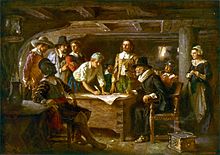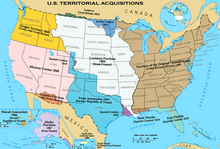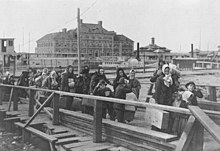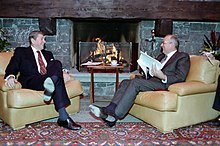User:Dead Mary/sandbox3
History
[edit]Native American and European contact
[edit]
The first North American settlers migrated from Siberia by way of the Bering land bridge approximately 15,000 or more years ago.[1][2][3] Some, such as the pre-Columbian Mississippian culture, developed advanced agriculture, grand architecture, and state-level societies. After European explorers and traders made the first contacts, the native population declined due to various reasons, including diseases such as smallpox and measles,[4][5] intermarriage,[6] and violence.[7][8][9]
In the early days of colonization many settlers were subject to shortages of food, disease and attacks from Native Americans. Native Americans were also often at war with neighboring tribes and allied with Europeans in their colonial wars.[10] At the same time however many natives and settlers came to depend on each other. Settlers traded for food and animal pelts, natives for guns, ammunition and other European wares.[11] Natives taught many settlers where, when and how to cultivate corn, beans and squash in the frontier. European missionaries and others felt it was important to "civilize" the Indians and urged them to concentrate on farming and ranching without depending on hunting and gathering.[12][13]
Settlements
[edit]After Columbus' first voyage to the New World in 1492 other explorers and settlement followed into the Floridas and the American Southwest.[14][15] There were also some French attempts to colonize the east coast, and later more successful settlements along the Mississippi River. Successful English settlement on the eastern coast of North America began with the Virginia Colony in 1607 at Jamestown and the Pilgrims' Plymouth Colony in 1620. Early experiments in communal living failed until the introduction of private farm holdings.[16] The continent's first elected legislative assembly, Virginia's House of Burgesses created in 1619, and the Mayflower Compact, signed by the Pilgrims before disembarking, established precedents for the pattern of representative self-government and constitutionalism that would develop throughout the American colonies.[17][18]

Most settlers in every colony were small farmers, but other industries developed. Cash crops included tobacco, rice and wheat. Extraction industries grew up in furs, fishing and lumber. Manufacturers produced rum and ships and by the late colonial period Americans were producing one-seventh of the world's iron supply.[19] Cities eventually dotted the coast to support local economies and serve as trade hubs. English colonists were supplemented by waves of Scotch-Irish and other groups. As coastal land grew more expensive freed indentured servants pushed further west.[20] Slave cultivation of cash crops began with the Spanish in the 1500s, and was adopted by the English, but life expectancy was much higher in North America because of less disease and better food and treatment, so the numbers of slaves grew rapidly.[21][22][23] Colonial society was largely divided over the religious and moral implications of slavery and colonies passed acts for and against the practice.[24][25] But by the turn of the 18th century, African slaves were replacing indentured servants for cash crop labor, especially in southern regions.[26]
With the 1732 colonization of Georgia, the 13 colonies that would become the United States of America were established.[27] All had local governments with elections open to most free men, with a growing devotion to the ancient rights of Englishmen and a sense of self-government stimulating support for republicanism.[28] With extremely high birth rates, low death rates, and steady settlement, the colonial population grew rapidly. Relatively small Native American populations were eclipsed.[29] The Christian revivalist movement of the 1730s and 1740s known as the Great Awakening fueled interest in both religion and religious liberty.
In the French and Indian War, British forces seized Canada from the French, but the francophone population remained politically isolated from the southern colonies. Excluding the Native Americans, who were being conquered and displaced, those 13 colonies had a population of over 2.1 million in 1770, about one-third that of Britain. Despite continuing new arrivals, the rate of natural increase was such that by the 1770s only a small minority of Americans had been born overseas.[30] The colonies' distance from Britain had allowed the development of self-government, but their success motivated monarchs to periodically seek to reassert Royal authority.
Independence and expansion
[edit]
The American Revolutionary War was the first successful colonial war of independence against a European power. Americans had developed an ideology of "republicanism" that held government rested on the will of the people as expressed in their local legislatures. They demanded their rights as Englishmen, “no taxation without representation”. The British insisted on administering the empire through Parliament, and the conflict escalated into war.[31] The Congress adopted the Declaration of Independence, on July 4, 1776, proclaiming that humanity is created equal in their inalienable rights. That date is now celebrated annually as America's Independence Day. In 1777, the Articles of Confederation established a weak government that operated until 1789.[32]
Britain recognized the independence of the United States following their defeat at Yorktown.[33] In the peace treaty of 1783, American sovereignty was recognized from the Atlantic coast west to the Mississippi River. Nationalists led the Philadelphia Convention of 1787 in writing the United States Constitution, and it was ratified in state conventions in 1788. The federal government was reorganized into three branches for their checks and balances in 1789. George Washington, who had led the revolutionary army to victory, was the first president elected under the new constitution. The Bill of Rights, forbidding federal restriction of personal freedoms and guaranteeing a range of legal protections, was adopted in 1791.[34]
Although the federal government criminalized the international slave trade in 1808, after 1820 cultivation of the highly profitable cotton crop exploded in the Deep South, and along with it the slave population.[35][36][37] The Second Great Awakening, beginning about 1800, converted millions to evangelical Protestantism. In the North it energized multiple social reform movements, including abolitionism,[38] in the South, Methodists and Baptists proselytized among slave populations.[39]
Americans' eagerness to expand westward prompted a long series of Indian Wars.[40] The Louisiana Purchase of French-claimed territory in 1803 almost doubled the nation's size.[41] The War of 1812, declared against Britain over various grievances and fought to a draw, strengthened U.S. nationalism.[42] A series of U.S. military incursions into Florida led Spain to cede it and other Gulf Coast territory in 1819.[43] Expansion was aided by steam power, when steamboats began traveling along America's large water systems, which were connected by new canals, such as the Erie and the I&M; then, even faster railroads began their stretch across the nation's land.[44]

From 1820 to 1850, Jacksonian democracy began a set of reforms which included wider male suffrage, and it led to the rise of the Second Party System of Democrats and Whigs as the dominant parties from 1828 to 1854. The Trail of Tears in the 1830s exemplified the Indian removal policy that moved Indians into the west to their own reservations. The U.S. annexed the Republic of Texas in 1845 during a period of expansionist Manifest Destiny.[45] The 1846 Oregon Treaty with Britain led to U.S. control of the present-day American Northwest.[46] Victory in the Mexican-American War resulted in the 1848 Mexican Cession of California and much of the present-day American Southwest.[47]
The California Gold Rush of 1848–49 spurred western migration and the creation of additional western states.[48] After the American Civil War, new transcontinental railways made relocation easier for settlers, expanded internal trade and increased conflicts with Native Americans.[49] Over a half-century, the loss of the buffalo was an existential blow to many Plains Indians cultures.[50] In 1869, a new Peace Policy sought to protect Native-Americans from abuses, avoid further warfare, and secure their eventual U.S. citizenship.[51]
Civil War and Reconstruction Era
[edit]
From the beginning of the United States, inherent divisions over slavery between the North and the South in American society ultimately led to the American Civil War.[52] Initially states entering the Union alternated slave and free, keeping a sectional balance in the Senate, while free states outstripped slave states in population and in the House of Representatives. But with additional western territory and more free-soil states, tensions between slave and free states mounted with arguments over federalism and disposition of the territories, whether and how to expand or restrict slavery.[53]
Following the 1860 election of Abraham Lincoln, the first president from the largely anti-slavery Republican Party, conventions in thirteen states ultimately declared secession and formed the Confederate States of America, while the U.S. federal government maintained secession was illegal.[53] The ensuing war was at first for Union, then after 1863 as casualties mounted and Lincoln delivered his Emancipation Proclamation, a second war aim became abolition of slavery. The war remains the deadliest military conflict in American history, resulting in the deaths of approximately 618,000 soldiers as well as many civilians.[54]
Following the Union victory in 1865, three amendments to the U.S. Constitution prohibited slavery, made the nearly four million African Americans who had been slaves[55] U.S. citizens, and promised them voting rights. The war and its resolution led to a substantial increase in federal power[56] aimed at reintegrating and rebuilding the Southern states while ensuring the rights of the newly freed slaves.[57] But following the Reconstruction Era, throughout the South Jim Crow laws soon effectively disenfranchised most blacks and some poor whites. Over the subsequent decades, in both the north and south blacks and some whites faced systemic discrimination, including racial segregation and occasional vigilante violence, sparking national movements against these abuses.[57]
Industrialization
[edit]
In the North, urbanization and an unprecedented influx of immigrants from Southern and Eastern Europe supplied a surplus of labor for the country's industrialization and transformed its culture.[58] National infrastructure including telegraph and transcontinental railroads spurred economic growth and greater settlement and development of the American Old West. The later invention of electric lights and telephones would also impact communication and urban life.[59] The end of the Indian Wars further expanded acreage under mechanical cultivation, increasing surpluses for international markets. Mainland expansion was completed by the Alaska Purchase from Russia in 1867. In 1898 the U.S. entered the world stage with important sugar production and strategic facilities acquired in Hawaii. Puerto Rico, Guam, and the Philippines were ceded by Spain in the same year, following the Spanish American War.
Rapid economic development at the end of the 19th century produced many prominent industrialists, and the U.S. economy became the world's largest. Dramatic changes were accompanied by social unrest and the rise of populist, socialist, and anarchist movements.[60] This period eventually ended with the beginning of the Progressive Era, which saw significant reforms in many societal areas, including women's suffrage, alcohol prohibition, regulation of consumer goods, greater antitrust measures to ensure competition and attention to worker conditions.
World War I, Great Depression, and World War II
[edit]
The United States remained neutral at the outbreak of World War I in 1914, though by 1917, it joined the Allies, helping to turn the tide against the Central Powers. President Woodrow Wilson took a leading diplomatic role at the Paris Peace Conference of 1919 and advocated strongly for the U.S. to join the League of Nations. However, the Senate refused to approve this, and did not ratify the Treaty of Versailles that established the League of Nations.[61]
In 1920, the women's rights movement won passage of a constitutional amendment granting women's suffrage.[62] The 1920s and 1930s saw the rise of radio for mass communication and the invention of early television.[63] The prosperity of the Roaring Twenties ended with the Wall Street Crash of 1929 and the onset of the Great Depression. After his election as president in 1932, Franklin D. Roosevelt responded with the New Deal, which included the establishment of the Social Security system.[64] The Dust Bowl of the mid-1930s impoverished many farming communities and spurred a new wave of western migration.
The United States was at first effectively neutral during World War II's early stages but began supplying material to the Allies in March 1941 through the Lend-Lease program. On December 7, 1941, the Empire of Japan launched a surprise attack on Pearl Harbor, prompting the United States to join the Allies against the Axis powers.[65] Though the nation lost more than 400,000 soldiers,[66] it emerged relatively undamaged from the war with even greater economic and military influence.[67] Allied conferences at Bretton Woods and Yalta outlined a new system of international organizations that placed the United States and Soviet Union at the center of world affairs. As an Allied victory was won in Europe, a 1945 international conference held in San Francisco produced the United Nations Charter, which became active after the war.[68] The United States developed the first nuclear weapons and used them on Japan; the Japanese surrendered on September 2, ending World War II.[69]
Cold War and Civil Rights era
[edit]
After World War II the United States and the Soviet Union jockeyed for power during what is known as the Cold War, driven by an ideological divide between capitalism and communism. They dominated the military affairs of Europe, with the U.S. and its NATO allies on one side and the USSR and its Warsaw Pact allies on the other. The U.S. developed a policy of "containment" toward Soviet bloc expansion. While they engaged in proxy wars and developed powerful nuclear arsenals, the two countries avoided direct military conflict. The U.S. often opposed Third World left-wing movements that it viewed as Soviet-sponsored. American troops fought Communist Chinese and North Korean forces in the Korean War of 1950–53. The Soviet Union's 1957 launch of the first artificial satellite and its 1961 launch of the first manned spaceflight initiated a "Space Race" in which the United States became the first to land a man on the moon in 1969.[70] A proxy war was expanded in Southeast Asia with the Vietnam War.
At home, the U.S. experienced sustained economic expansion and a rapid growth of its population and middle class. Construction of an interstate highway system transformed the nation’s infrastructure over the following decades. Millions moved from farms and inner cities to large suburban housing developments.[71][72] A growing Civil Rights movement used nonviolence to confront segregation and discrimination, with Martin Luther King Jr. becoming a prominent leader and figurehead. A combination of court decisions and legislation, culminating in the Civil Rights Act of 1964, sought to end racial discrimination.[73][74][75] Meanwhile, a counterculture movement grew which was fueled by opposition to the Vietnam war, black nationalism, and the sexual revolution. The launch of a "War on Poverty" expanded entitlement and welfare spending.[76]
The 1970s and early 1980s saw the onset of stagflation. After his election in 1980, President Ronald Reagan responded to economic stagnation with free-market oriented reforms. Following the collapse of détente, he abandoned "containment" and initiated the more aggressive "rollback" strategy towards the USSR.[77][78][79][80][81] After a surge in female labor participation over the previous decade, by 1985 a majority of women age 16 and over were employed.[82] The late 1980s brought a "thaw" in relations with the USSR, and its collapse in 1991 finally ended the Cold War.[83][84][85][86]
Contemporary history
[edit]After the Cold War, the 1990s saw the longest economic expansion in modern U.S. history, ending in 2001.[87] Originating in U.S. defense networks, the Internet spread to international academic networks, and then to the public in the 1990s, greatly impacting the global economy, society, and culture.[88] On September 11, 2001, al-Qaeda terrorists struck the World Trade Center in New York City and the Pentagon near Washington, D.C., killing nearly 3,000 people.[89] In response the United States launched the War on Terror, which includes the ongoing war in Afghanistan and the 2003–11 Iraq War.[90][91] In 2008, amid the Great Recession, Barack Obama was elected president, becoming the first African-American to take the office.[92]
- ^ Maugh II, Thomas H. (July 12, 2012). "Who was first? New info on North America's earliest residents". Los Angeles Times.
- ^ "What is the earliest evidence of the peopling of North and South America?". Smithsonian Institution, National Museum of Natural History. June 2004. Archived from the original on November 28, 2007. Retrieved June 19, 2007.
- ^ Kudeba, Nicolas (February 28, 2014). "Chapter 1 – The First Big Steppe – Aboriginal Canadian History". The History of Canada Podcast. Archived from the original on March 1, 2014.
- ^ "The Cambridge encyclopedia of human paleopathology". Arthur C. Aufderheide, Conrado Rodríguez-Martín, Odin Langsjoen (1998). Cambridge University Press. p. 205. ISBN 0-521-55203-6
- ^ Bianchine, Russo, 1992 pp. 225–232
- ^ Mann, 2005 p. 44
- ^ Thornton, 1987 p. 49
- ^ Kessel, 2005 pp. 142–143
- ^ Mercer Country Historical Society, 2005
- ^ Juergens, 2011, p. 69
- ^ Ripper, 2008 p. 6
- ^ Ripper, 2008 p. 5
- ^ Calloway, 1998, p. 55
- ^ Taylor, pp. 33–34
- ^ Taylor, pp. 72, 74
- ^ Walton, 2009, pp. 29–31
- ^ Remini, 2007, pp. 2–3
- ^ Johnson, 1997, pp. 26–30
- ^ Walton, 2009, chapter 3
- ^ Lemon, 1987
- ^ Clingan, 2000, p. 13
- ^ Tadman, 2000, p. 1534
- ^ Schneider, 2007, p. 484
- ^ Lien, 1913, p. 522
- ^ Davis, 1996, p. 7
- ^ Quirk, 2011, p. 195
- ^ Bilhartz, Terry D.; Elliott, Alan C. (2007). Currents in American History: A Brief History of the United States. M.E. Sharpe. ISBN 978-0-7656-1817-7.
- ^ Wood, Gordon S. (1998). The Creation of the American Republic, 1776–1787. UNC Press Books. p. 263. ISBN 978-0-8078-4723-7.
- ^ Walton, 2009, pp. 38–39
- ^ Walton, 2009, p. 35
- ^ Humphrey, Carol Sue (2003). The Revolutionary Era: Primary Documents on Events from 1776 To 1800. Greenwood Publishing. pp. 8–10. ISBN 978-0-313-32083-5.
- ^ Fabian Young, Alfred; Nash, Gary B.; Raphael, Ray (2011). Revolutionary Founders: Rebels, Radicals, and Reformers in the Making of the Nation. Random House Digital. pp. 4–7. ISBN 978-0-307-27110-5.
- ^ Greene and Pole, A Companion to the American Revolution p 357. Jonathan R. Dull, A Diplomatic History of the American Revolution (1987) p. 161. Lawrence S. Kaplan, "The Treaty of Paris, 1783: A Historiographical Challenge," International History Review, Sept 1983, Vol. 5 Issue 3, pp 431–442
- ^ Boyer, 2007, pp. 192–193
- ^ Cogliano, Francis D. (2008). Thomas Jefferson: Reputation and Legacy. University of Virginia Press. p. 219. ISBN 978-0-8139-2733-6.
- ^ Walton, 2009, p. 43
- ^ Gordon, 2004, pp. 27,29
- ^ Clark, Mary Ann (May 2012). Then We'll Sing a New Song: African Influences on America's Religious Landscape. Rowman & Littlefield. p. 47. ISBN 978-1-4422-0881-0.
- ^ Heinemann, Ronald L., et.al., Old Dominion, New Commonwealth: a history of Virginia 1607-2007, 2007 ISBN 978-0-8139-2609-4, p.197
- ^ Billington, Ray Allen; Ridge, Martin (2001). Westward Expansion: A History of the American Frontier. UNM Press. p. 22. ISBN 978-0-8263-1981-4.
- ^ "Louisiana Purchase". National Park Services. Retrieved March 1, 2011.
- ^ Wait, Eugene M. (1999). America and the War of 1812. Nova Publishers. p. 78. ISBN 978-1-56072-644-9.
- ^ Klose, Nelson; Jones, Robert F. (1994). United States History to 1877. Barron's Educational Series. p. 150. ISBN 978-0-8120-1834-9.
- ^ Winchester, pp. 198, 216, 251, 253
- ^ Morrison, Michael A. (1999). Slavery and the American West: The Eclipse of Manifest Destiny and the Coming of the Civil War. University of North Carolina Press. pp. 13–21. ISBN 978-0-8078-4796-1.
- ^ Kemp, Roger L. (2010). Documents of American Democracy: A Collection of Essential Works. McFarland. p. 180. ISBN 978-0-7864-4210-2.
- ^ McIlwraith, Thomas F.; Muller, Edward K. (2001). North America: The Historical Geography of a Changing Continent. Rowman & Littlefield. p. 61. ISBN 978-0-7425-0019-8.
- ^ Smith-Baranzini, Marlene (1999). A Golden State: Mining and Economic Development in Gold Rush California. University of California Press. p. 20. ISBN 978-0-520-21771-3.
- ^ Black, Jeremy (2011). Fighting for America: The Struggle for Mastery in North America, 1519–1871. Indiana University Press. p. 275. ISBN 978-0-253-35660-4.
- ^ Wishart, David J. (2004). Encyclopedia of the Great Plains. University of Nebraska Press. p. 37. ISBN 978-0-8032-4787-1.
- ^ Smith (2001), Grant, pp. 523–526
- ^ Stuart Murray (2004). Atlas of American Military History. Infobase Publishing. p. 76. ISBN 978-1-4381-3025-5.
- ^ a b Patrick Karl O'Brien (2002). Atlas of World History. Oxford University Press. p. 184. ISBN 978-0-19-521921-0.
- ^ Vinovskis, Maris (1990). Toward A Social History of the American Civil War: Exploratory Essays. Cambridge; New York: Cambridge University Press. p. 4. ISBN 0-521-39559-3.
- ^ "1860 Census" (PDF). U.S. Census Bureau. Retrieved June 10, 2007. Page 7 lists a total slave population of 3,953,760.
- ^ De Rosa, Marshall L. (1997). The Politics of Dissolution: The Quest for a National Identity and the American Civil War. Edison, NJ: Transaction. p. 266. ISBN 1-56000-349-9.
- ^ a b G. Alan Tarr (2009). Judicial Process and Judicial Policymaking. Cengage Learning. p. 30. ISBN 978-0-495-56736-3.
- ^ John Powell (2009). Encyclopedia of North American Immigration. Infobase Publishing. p. 74. ISBN 978-1-4381-1012-7.
- ^ Winchester, pp. 351, 385
- ^ Zinn, Howard (2005). "The Socialist Challenge". A People's History of the United States. New York: Harper Perennial Modern Classics. pp. 321–357. ISBN 0-06-083865-5.
- ^ McDuffie, Jerome; Piggrem, Gary Wayne; Woodworth, Steven E. (2005). U.S. History Super Review. Piscataway, NJ: Research & Education Association. p. 418. ISBN 0-7386-0070-9.
- ^ Voris, Jacqueline Van (1996). Carrie Chapman Catt: A Public Life. Women and Peace Series. New York City: Feminist Press at CUNY. p. vii. ISBN 1-55861-139-8.
Carrie Chapmann Catt led an army of voteless women in 1919 to pressure Congress to pass the constitutional amendment giving them the right to vote and convinced state legislatures to ratify it in 1920. ... Catt was one of the best-known women in the United States in the first half of the twentieth century and was on all lists of famous American women.
- ^ Winchester pp. 410–411
- ^ Axinn, June; Stern, Mark J. (2007). Social Welfare: A History of the American Response to Need (7th ed.). Boston: Allyn & Bacon. ISBN 978-0-205-52215-6.
- ^ Burton, Jeffrey F.; et al. (July 2000). "A Brief History of Japanese American Relocation During World War II". Confinement and Ethnicity: An Overview of World War II Japanese American Relocation Sites. National Park Service. Retrieved April 2, 2010.
{{cite web}}: Explicit use of et al. in:|author=(help) - ^ Leland, Anne; Oboroceanu, Mari–Jana (February 26, 2010). "American War and Military Operations Casualties: Lists and Statistics" (PDF). Congressional Research Service. Retrieved February 18, 2011. p. 2.
- ^ Kennedy, Paul (1989). The Rise and Fall of the Great Powers. New York: Vintage. p. 358. ISBN 0-679-72019-7. Indeed, World War II ushered in the zenith of U.S. power in what came to be called the American Century, as Leffler 2010, p. 67, indicates: "Truman presided over the greatest military and economic power the world had ever known. War production had lifted the United States out of the Great Depression and had inaugurated an era of unimagined prosperity. Gross national product increased by 60 percent during the war, total earnings by 50 percent. Despite social unrest, labor agitation, racial conflict, and teenage vandalism, Americans had more discretionary income than ever before. Simultaneously, the U.S. government had built up the greatest war machine in human history. By the end of 1942, the United States was producing more arms than all the Axis states combined, and, in 1943, it made almost three times more armaments than did the Soviet Union. In 1945, the United States had two-thirds of the world's gold reserves, three-fourths of its invested capital, half of its shipping vessels, and half of its manufacturing capacity. Its GNP was three times that of the Soviet Union and more than five times that of Britain. It was also nearing completion of the atomic bomb, a technological and production feat of huge costs and proportions."
- ^ "The United States and the Founding of the United Nations, August 1941 – October 1945". U.S. Dept. of State, Bureau of Public Affairs, Office of the Historian. October 2005. Archived from the original on June 12, 2007. Retrieved June 11, 2007.
- ^ Pacific War Research Society (2006). Japan's Longest Day. New York: Oxford University Press. ISBN 4-7700-2887-3.
- ^ Collins, Michael (1988). Liftoff: The Story of America's Adventure in Space. New York: Grove Press.
- ^ Winchester, pp. 305-308
- ^ "History and cultural impact of the Interstate Highway system". Uvm.edu. Retrieved 2014-02-15.
- ^ Dallek, Robert (2004). Lyndon B. Johnson: Portrait of a President. Oxford University Press. p. 169. ISBN 978-0-19-515920-2.
- ^ "Our Documents – Civil Rights Act (1964)". United States Department of Justice. Retrieved July 28, 2010.
- ^ "Remarks at the Signing of the Immigration Bill, Liberty Island, New York". October 3, 1965. Retrieved January 1, 2012.
- ^ Social Security History, the United States Social Security Administration
- ^ Soss, 2010, p. 277
- ^ Fraser, 1989
- ^ Ferguson, 1986, pp. 43–53
- ^ Williams, pp. 325–331
- ^ Niskanen, William A. (1988). Reaganomics: an insider's account of the policies and the people. Oxford University Press. p. 363. ISBN 978-0-19-505394-4.
- ^ "Women in the Labor Force: A Databook" (PDF). U.S. Bureau of Labor Statistics. 2013. p. 11. Retrieved 21 March 2014.
- ^ Howell, Buddy Wayne (2006). The Rhetoric of Presidential Summit Diplomacy: Ronald Reagan and the U.S.-Soviet Summits, 1985—1988. Texas A&M University. p. 352. ISBN 978-0-549-41658-6.
- ^ Kissinger, Henry (2011). Diplomacy. Simon and Schuster. pp. 781–784. ISBN 978-1-4391-2631-8.
Mann, James (2009). The Rebellion of Ronald Reagan: A History of the End of the Cold War. Penguin. p. 432. ISBN 978-1-4406-8639-9.
- ^ Hayes, 2009
- ^ US History.org, 2013
- ^ Voyce, Bill (August 21, 2006). "Why the Expansion of the 1990s Lasted So Long". Iowa Workforce Information Network. Retrieved August 16, 2007.
Dale, Reginald (February 18, 2000). "Did Clinton Do It, or Was He Lucky?". The New York Times. Retrieved March 6, 2013.
Mankiw, N. Gregory (2008). Macroeconomics. Cengage Learning. p. 559. ISBN 978-0-324-58999-3. - ^ Winchester, pp. 420-423
- ^ Flashback 9/11: As It Happened. Fox News. September 9, 2011. Retrieved March 6, 2013.
"America remembers Sept. 11 attacks 11 years later". CBS News. Associated Press. September 11, 2012. Retrieved March 6, 2013.
"Day of Terror Video Archive". CNN. 2005. Retrieved March 6, 2013. - ^ Walsh, Kenneth T. (December 9, 2008). "The 'War on Terror' Is Critical to President George W. Bush's Legacy". U.S. News & World Report. Retrieved March 6, 2013.
Atkins, Stephen E. (2011). The 9/11 Encyclopedia: Second Edition. ABC-CLIO. p. 872. ISBN 978-1-59884-921-9. - ^ Wong, Edward (February 15, 2008). "Overview: The Iraq War". The New York Times. Retrieved March 7, 2013.
Johnson, James Turner (2005). The War to Oust Saddam Hussein: Just War and the New Face of Conflict. Rowman & Littlefield. p. 159. ISBN 978-0-7425-4956-2.
Durando, Jessica; Rae Green, Shannon (December 21, 2011). "Timeline: Key moments in the Iraq War". USA Today. Associated Press. Retrieved March 7, 2013. - ^ Washington, Jesse; Rugaber, Chris (September 9, 2011). "African-American Economic Gains Reversed By Great Recession". Huffington Post. Associated Press. Retrieved March 7, 2013.
Hargreaves, Steve (November 5, 2008). "Obama rides economy to White House". CNN. Retrieved March 7, 2013.
One Year In, a Closer Look at the Obama Presidency. MacNeil/Lehrer Production. 2010. Retrieved March 7, 2012.


